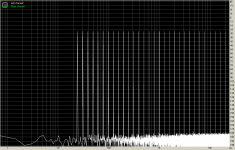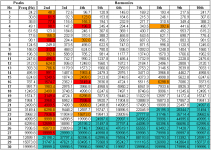And thank goodness evolution thought feedback was a good idea. We'd have real problems without that.
Why does the language
Matt, when I looked at their site and read all the pages, I wasn’t sure what was it all about.
I couldn’t understand what each of their products does.
Clearly, I am not up to their level.
I had to turn to some videoclips at youtube to understand what they sell.
Once, not long ago
Thank you Frans. When you’ll have the chance to audition the Phantoms, please give us a feedback.
George - Those test files have two versions IIRC one for 64K FFT's and one for an FFT of exactly the sample rate. The later is only useful to those who use one of the comprehensive open source libraries like Octave, PYTHON, etc. The first gives right answers for ONLY 65536 length FFT's which are almost always available on the free tools I see folks use here.
Scott, I quote from your article (Linear Audio Volume 10)
“The files are in 24bit/96kHz stereo.wav format. There are two versions of each, one for 64k FFT’s and one for 96k FFT’s with the intent that with no windowing, individual frequencies and the noise floor can be completely resolved. As a reminder these files only give the desired result at exactly the matching FFT length.”
Attached is the “desired result” for the 64k file done with the free RMAA
PavelThis "silence between the notes" is something like
I agree with what you say about what lies behind the terms "tight bass" and "clean sounding".
Now I have to build some experience to deal with the third term "silence between the notes"
George
Attachments
Attached is the “desired result” for the 64k file done with the free RMAA
As usual thanks George, I remember being pretty clear on their use. Nonetheless people PM me asking why their favorite windowing and 8k FFT's don't look like the published results.
Always smile at this, I lost my little buddy this year and one of my fondest memories is when he chased monarchs around and around a patch of milkweeds never tiring and never figuring out that you can't catch them.(If you ain't at least smiling...)
The build it, see how it sounds, and make up a story design technique won't go away...
With lots of sample circuits available to use as templates or from which to mix and match, with LTSpice to model whatever circuit one wishes, and with low cost test instruments for basic measurements, it has more than ever made design accessible to people that otherwise wouldn't be able to do it due to a lack of formal education.
When you ask, "how does it work?" the answer can only be based on general intuition, not expert intuition, and on whatever explanations are commonly believed by communities of similar or like-minded folks.
The production of stories doesn't go away because the brain produces and believes stories based on what one has learned, be it correct or incorrect information. Unless such designers undertake to learn all the rest of the stuff degreed engineers are required to study in school, they can only continue to produce the stories they do.
I remember being pretty clear on their use.
You are welcome Scott, (we are thanking you)
30 tone-test, 150dB above noise floor is an extreme test signal.
Any kind of nonlinearity products will raise the noise floor.
When testing, the question is not if but how much the noise floor will raise.
George
Any kind of nonlinearity products will raise the noise floor.
Only second harmonics and a few of fourths fall on FFT bins and won’t show as increased noise floor.
In red the harmonics that fall dead centre an FFT frequency bin.
In orange the harmonics that fall on the skirts of an FFT frequency bin.
George
Attachments
Linn Urika II RIAA MC preamplifier
Analog flat preamplifier plus the 75usec rolloff in hardware. Then ADC and DSP implementation of the remaining RIAA deemphasis plus a rumble filter. Digital output
All the audiophile jargon superlatives for how it sounds.
Google Translate
George
Analog flat preamplifier plus the 75usec rolloff in hardware. Then ADC and DSP implementation of the remaining RIAA deemphasis plus a rumble filter. Digital output
All the audiophile jargon superlatives for how it sounds.
Google Translate
George
Attachments
Matt, when I looked at their site and read all the pages, I wasn’t sure what was it all about.
I couldn’t understand what each of their products does.
Clearly, I am not up to their level.
I had to turn to some videoclips at youtube to understand what they sell.
Thank you Frans. When you’ll have the chance to audition the Phantoms, please give us a feedback.
Scott, I quote from your article (Linear Audio Volume 10)
“The files are in 24bit/96kHz stereo.wav format. There are two versions of each, one for 64k FFT’s and one for 96k FFT’s with the intent that with no windowing, individual frequencies and the noise floor can be completely resolved. As a reminder these files only give the desired result at exactly the matching FFT length.”
Attached is the “desired result” for the 64k file done with the free RMAA
Pavel
I agree with what you say about what lies behind the terms "tight bass" and "clean sounding".
Now I have to build some experience to deal with the third term "silence between the notes"
George
Many years ago, Peter Moncrieff borrowed a high speed sampler with deep memory and played music with and without electrolytic coupling cap. before this, he heard the noise between notes also and called it a decrease in Inter-transient silence. he showed me the captured music transient signal and sure enough the bottom was filled in. Another example of DA affects.... were not seen with PP or PS types with this test.
In this multi-tone test of noise freqs/harmonics/IM, It also has similar sonic affect as reducing the inter-transient silence. Or, you can also experience a slight loss in dynamic range and any real details can me masked by the accumulated level of distortions/noise.
As for bass, the tightness is also associated with the LF group delay and the cone/magnet acoustic decay time. Tighten up the decay time (especially a resonance) and you will tighten up the bass quality/sound. The affect of 2H is to add a thickness or weight (louder?) to the bass that isn't really there.
THx-RNMarsh
Last edited:
he showed me the captured music transient signal and sure enough the bottom was filled in. Another example of DA affects.... were not seen with PP or PS types with this test.
Dream on. Pease's simple R/C ladder model works just fine. The idea that DA is some kind of "echo" or memory is simply a nonsense plain and simple.
Another example of DA affects.... were not seen with PP or PS types with this test.
THx-RNMarsh
So what causes the observed effects then ?......The idea that DA is some kind of "echo" or memory is simply a nonsense plain and simple.
Dan.
Evolution is an 'open' system, ie mutagenic changes are random within constraints.And thank goodness evolution thought feedback was a good idea. We'd have real problems without that.
These changes may or may not be advantageous according to local environmental conditions, with the non advantageous changes being out competed by advantageous changes.
This is process of elimination, not feedback.
Dan.
I meant the huge number of feedback mechanisms we have that actually make us able to function. A simple one being proprioception. If you didn't have a positional feedback mechanism to tell your brain where your limbs were all sorts of things would become incredibly difficult. Like walking.
Ok.I meant the huge number of feedback mechanisms we have that actually make us able to function......
Dan.
So what causes the observed effects then ?.
Dan.
Someone suggests an effect and then folks make up what they want to believe. The usual explanations violate causality and/or superposition so you guys have to do better than a bunch of anecdotal stories to throw out our understanding of physics.
Last edited:
Someone suggests an effect and then folks make up what they want to believe. The usual explanations violate causality and/or superposition so you guys have to do better than a bunch of anecdotal stories to throw out our understanding of physics.
Are you guys all talking about the same thing? Sometimes there is sort of low level smearing of sound that can be heard in some equipment. It's not a echo, but perceptually it seems have a non-time-invariant aspect to what it sounds like it's doing. Maybe it could have something to do with electrons getting absorbed in some dielectric as voltage goes up, and as they come back out as voltage goes down. (If not a primary effect, maybe an associated low level 2nd or 3rd order effect?) What that might sound like perceptually to some people if it occurs at a very low level might or might not be the sort-of-little-signal-smearing-along-with-some-low-level-hash-noise I have heard. (I don't know if the noise and smearing are due to the same effect or not, they are both low level is all, and I tend to notice them at the same time) Is that what is being discussed or is it some other effect? If something else, what exactly?
Last edited:
Scott has certainly changed his opinion over the decades. However, I am probably the first person found guilty of calling DA something like an echo back in 1984, and I was 'jumped on' by Dr. Lipshitz, Doug Self, and many others at the time. However, what DA does is generate measurable signal that is derived from an initial event but is presented AFTER the initial event has past, sometimes milliseconds later, sometimes weeks or months after the event. What would you call it?
- Status
- Not open for further replies.
- Home
- Member Areas
- The Lounge
- John Curl's Blowtorch preamplifier part II


